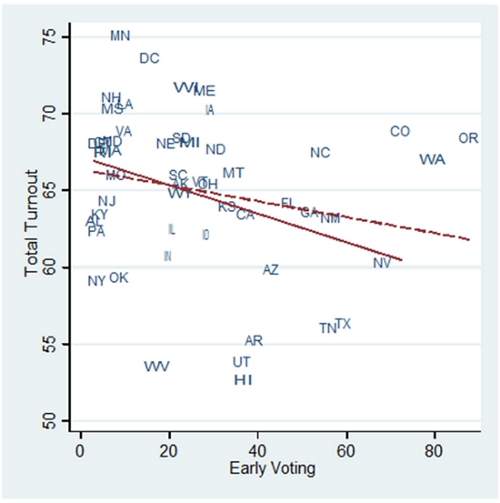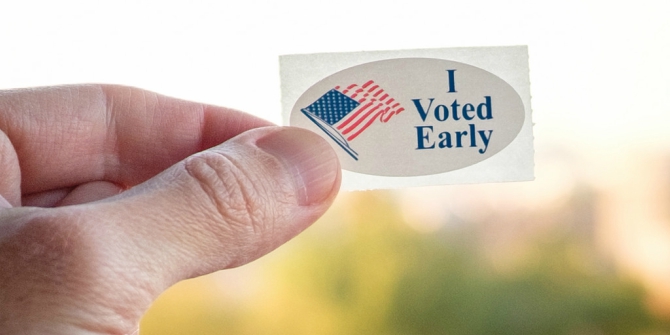 Politicians and commentators have been concerned about election turnout rates for decades, and there have been significant efforts to make voting easier in order to address this concern. Barry C. Burden, David T. Canon, Kenneth R. Mayer, and Donald P. Moynihan take a close look at the policy of early voting across the U.S. They find that, if implemented on its own, early voting has the effect of actually decreasing turnout, by robbing election day of its otherwise stimulating effect on nonvoters and marginal voters. The authors argue that the most effective way to increase turnout is to allow voters to register when they vote, on election day, or beforehand.
Politicians and commentators have been concerned about election turnout rates for decades, and there have been significant efforts to make voting easier in order to address this concern. Barry C. Burden, David T. Canon, Kenneth R. Mayer, and Donald P. Moynihan take a close look at the policy of early voting across the U.S. They find that, if implemented on its own, early voting has the effect of actually decreasing turnout, by robbing election day of its otherwise stimulating effect on nonvoters and marginal voters. The authors argue that the most effective way to increase turnout is to allow voters to register when they vote, on election day, or beforehand.
Advocates, journalists, and politicians frequently propose changes to election laws out of the belief that making voting easier will increase voter turnout. It seems logical that more people will vote if we make voting more convenient – in the United States this takes the form of relaxed voter registration rules, registration on, and voting prior to, election day, or expanded absentee voting. We challenge this notion, and show that the most popular reform adopted by US state governments – early voting – actually decreases turnout when implemented by itself, an unanticipated consequence that has significant implications for policy and for theories of how state governments can influence turnout.
The idea that early voting could reduce turnout is counterintuitive, and it certainly runs against the grain of conventional wisdom. We make sense of this by pointing out that the overall impact of any election law on turnout depends on its net consequences and its joint effect with other election laws. The net consequences are based on both direct and indirect effects. Direct effects stem from the costs imposed by the state, and include registration requirements, polling locations and hours, and rules such as identification requirements. Most research has focused on these direct effects while ignoring how election laws indirectly affect mobilization by non-governmental actors such as the media, campaigns, interest groups, friends, and family. These actors indirectly raise or lower the costs of voting depending on how much information they provide and the social incentives for voting they generate. The added convenience of early voting decreases the direct costs of voting, but this effect is more than offset by a reduction in mobilization efforts, resulting in lower net turnout. The joint effect of election laws is also important. The combinations of election day registration (EDR), same day registration (SDR), and early voting have different impacts on turnout depending on how they are combined. For example, on their own, EDR increases turnout and early voting decreases it. Combining the two offsets the negative effect of early voting.

Before explaining these results, we should define the various types of laws. Early voting, as we define it, constitutes practices that permit voters to cast ballots without excuse prior to election day. Early voting in the US has more than quadrupled since the early 1990s, increasing from 7 percent of all votes in 1992 to over 30 percent in 2012. Now more than half of the states allow early voting in some form. EDR permits eligible voters to both register and vote on election day. This should increase turnout by eliminating the need for two separate actions: registering in advance and then casting a ballot at a later date. Same-day registration (SDR) permits people to both register and vote in a single act prior to election day. It thus reduces the potential inconvenience of having to vote on a specific election day, eliminates the registration closing date, and permits “one-stop shopping.”
Early voting, by itself, does not help people who are not already registered to vote. SDR and especially EDR eliminate this problem by allowing individuals who become interested late in the campaign to be mobilized into voting. By offering more days on which to vote, early voting lowers the direct costs of voting, but mostly as a convenience for those who were already planning to vote. Registration statistics confirms this effect: in the states that had early voting and SDR in 2008, 3.6 million same day registration applications were filed; of those, only 963,144 (or about 27 percent) were new voters added to the registration rolls for the first time. Early voting almost certainly brings out some new voters who would have difficulty making it to the polls on election day (the direct effect), but it more than offsets this increase by dissipating the energy of election day over a longer period of time and reducing mobilization (the indirect effect).
We suggest that early voting robs election day of the stimulating effect it would otherwise have on nonvoters or marginal voters. This stimulation can come via the social incentives and civic activities that surround election day. Political campaigns also strategically consider the political environment as they choose to invest resources to mobilize voters. Partisan contacts, direct mail, phone calls, leafleting, and mass media, levels of competition and campaign spending, campaign advertising, campaign yard signs, texts, party transfers to states and campaign visits by presidential candidates all have an impact on turnout. Campaigns may draw down their mobilization efforts when they have already brought in large numbers of early voters: there may be less advertising and fewer efforts to organize election day activities. We find that presidential campaign advertising tails off in states with significant early voting in comparison to states without it. When much of the eligible population has already voted in advance of election day, there is less payoff for continued get-out-the-vote activities. If this reduced activity in high early voting states is not counterbalanced by the increased convenience of voting prior to the election, the net effect would be negative.
This claim is supported by the simple bivariate data shown in Figure 1. States with higher levels of early voting have lower turnout:
Figure 1: Early Voting and Turnout in the States in 2008

Note: Dotted regression line represents all states. Solid regression line omits Oregon and Washington, which conduct elections by mail.
Our analysis controls for alternative explanations with individual and county-level data from the 2004 and 2008 presidential elections using a variety of methods. Our empirical claims stand up to these various tests: despite being the most popular election reform, early voting depresses net voter turnout and the only consistent way to increase turnout is to permit election day registration. This effect is only partially offset if SDR is present, or if EDR offers a vehicle for the last-minute mobilization of marginal voters. This result upends the conventional view that anything that makes voting easier will raise turnout. At the same time, our results offer a clear prescription for policymakers who seek to increase turnout: let voters register when they vote.
This post is based on the article “Election Laws, Mobilization, and Turnout: The Unanticipated Consequences of Election Reform” in the American Journal of Political Science.
Please read our comments policy before commenting.
Note: This article gives the views of the author, and not the position of USApp– American Politics and Policy, nor of the London School of Economics.
Shortened URL for this post: http://bit.ly/1bJzeER
_________________________________________
 Barry C. Burden – University of Wisconsin-Madison
Barry C. Burden – University of Wisconsin-Madison
Barry Burden is Professor of Political Science at the University of Wisconsin-Madison. His research and teaching are based in American politics, with an emphasis on electoral politics and representation. He is author of Personal Roots of Representation (Princeton University Press, 2007), co-author of Why Americans Split Their Tickets: Campaigns, Competition, and Divided Government (University of Michigan Press, 2004), editor of Uncertainty in American Politics (Cambridge University Press, 2003) and co-editor with Charles Stewart III of a forthcoming volume, The Measure of American Elections.
 David T. Canon – University of Wisconsin-Madison
David T. Canon – University of Wisconsin-Madison
David T. Canon is a professor of Political Science at the University of Wisconsin, Madison. His research interests are in American political institutions, especially Congress. He latest books include The Dysfunctional Congress? The Individual Roots of an Institutional Dilemma (with Ken Mayer; 2nd ed. forthcoming with Columbia University Press), and American Politics Today (with William Bianco, WW Norton, 3rd ed., 2013). His most recent research concerns election administration and election reform (with a continued interest in redistricting).
 Kenneth R. Mayer – University of Wisconsin-Madison
Kenneth R. Mayer – University of Wisconsin-Madison
Kenneth Mayer is a Professor of Political Science at the University of Wisconsin-Madison. His research interests include presidential powers, legislative redistricting, campaign finance reform, election law and administration and defense policy.
_
 Donald P. Moynihan – University of Wisconsin-Madison
Donald P. Moynihan – University of Wisconsin-Madison
Donald Moynihan is Professor of Public Affairs at the LaFollette School of Public Affairs, at the University of Wisconsin-Madison. His research examines the application of organization theory to public management issues such as performance, budgeting, homeland security, election administration, and employee behavior. In particular, he studies the selection and implementation of public management reforms.




